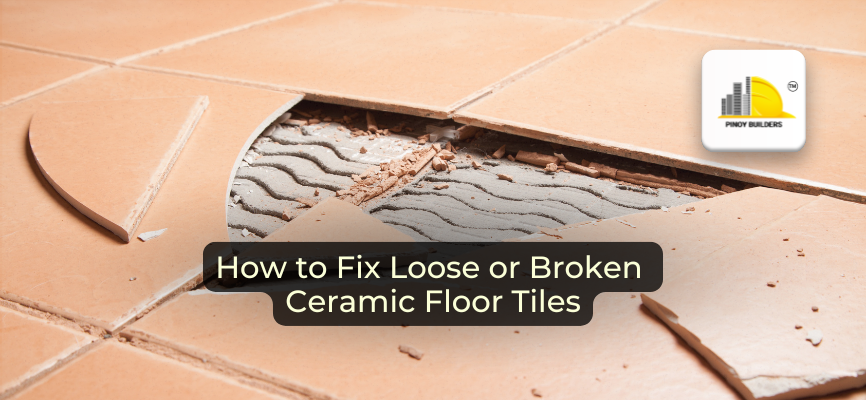Tiles are a common flooring option in bathrooms and kitchens, because they are sturdy, waterproof, and easy to clean. Despite this, floor tiles eventually wear out, crack, or loosen when used in high-traffic areas. It’s best to deal with the problem before it worsens, such as water seeping under the cracked tile and causing mold to grow.
Photo Courtesy: Facebook
This article will help you understand why floor tiles loosen and how to fix them, whether you’re a flooring expert or new to the home improvement world.
What causes floor tiles to crack and loosen?
There are several reasons floor tiles can become loose, including:
Moisture Infiltration
Moisture beneath tiles can cause a weakened substrate-tile bond (the substrate is the tile installation surface). Vapor may enter your home through the concrete slab, causing the tiles to lift. Sometimes, a loose tile could mean an unseen plumbing leak within a wall. Remove all loose tile pieces one by one.
Photo Courtesy: my59ranch.com
Check the substrate, which could be concrete, cement board, or plywood. Check for dampness and mold caused by moisture. If moisture is seeping through the concrete slab, contact a professional. Remove any mildew with a bleach solution before restoring the tile. In the worst-case scenario, contact a mold expert.
Movement in the House
Houses settle over time, and as the base changes and the walls move, the movements leave a small space between the wall and the floor tiles.
Adhesive types
With some adhesives that are not strong enough, tiles can loosen up. Even the highest-quality bonds will eventually wear out.
Temperature variations
Tiles expand in the heat and shrink in the cold. While this is normal, heat shifts can cause tiles to loosen or break.
Bonding on the spot
Spot bonding is a method of laying tile in which they place a dot of adhesive on each corner and one in the center of the tile before pressing it into place. This approach allows for too many spaces between the tiles, loosening them.
Check for ‘kapak’
One sure sign of loose tiles is ‘kapak’. This happens when the adhesive forms air pockets between the tile and the cement during the installation process. To check, tap the corners and central area of the tile with a coin. If you hear a hollow sound when tapping the tile, then you’ll need to reinstall it with enough adhesive to prevent air pockets.
How to fix cracked tiles
Photo Courtesy: Wikimedia Commons
Cracked tiles are impossible to reassemble perfectly. It also does more harm than good to put them back together. Here’s how to replace the tile instead:
- Cut the grout around the broken floor tiles.
- Lift the broken tile. If you cannot, break it into a few pieces using a hammer or drill.
- Before moving on to the next step, vacuum up the debris.
- Apply new mastic to the new tile.
- Regrout.
It’s important to remember that when replacing a cracked tile, especially kitchen tiles, be careful not to damage the surrounding tiles.
How to Prevent Loose Tile
Whatever caused the tiles to lift, you may need to remove the tile and possibly the substrate. Use a small crowbar and a carpenter’s hammer. Don’t exert too much pressure.
Photo Courtesy: Homely Ville
Before removing individual tiles, especially granite tiles, remove the adjoining grout with a carbide-tipped grout saw. Pry up the first piece’s perimeter until you hear a slight popping sound. This means the part is no longer bonded to the substrate. With a 4-inch grinder, remove the thin-set from the back of the tile to reuse it. Before reinstalling, clean the substrate and make any necessary repairs.
To deal with a loose floor tile or several loose floor tiles:
- Remove the loose tiles.
- If the adjacent tiles are flexible, scrape out the grout surrounding them and carefully peel them out.
- You can do this by inserting a putty knife under the tiles and breaking them free from any remaining mastic.
- Scrape the underside of the tiles to remove any old mastic and apply new mastic.
- Position the tiles in place, let them dry for 24 hours, and then re-grout them.
Another option is to inject the spaces it with a specific adhesive to detect any existing voids. You can do this without raising the tile, removing any grout, or creating any unwanted noise or mess.
For a flawless tile installation, use Holcim Tile Adhesive to keep your tiles firm and durable! Holcim Tile Adhesive is a polymer-modified mortar for installing all ceramic tiles, marble, granite, and natural stones to walls and floors by a thin-bed method. Keep your tiles sturdy and free from ‘kapak with Holcim Tile Adhesive!
CITATIONS:
- Daniel, Tim. “What Causes Tile to Lift Up?” Hunker, Hunker, 27 Aug. 2011, www.hunker.com/13402590/what-causes-tile-to-lift-up.
- “How to Fix Loose or Broken Ceramic Floor Tiles.” Www.floortraderofvirginia.com, www.floortraderofvirginia.com/custom/ft0035/fix-cracked-tiles. Accessed 26 Nov. 2021.
- “How to Fix Loose Tiles.” Barefoot Floors, www.barefootfloors.com.au/what-causes-loose-tiles. Accessed 26 Nov. 2021.
![]()












